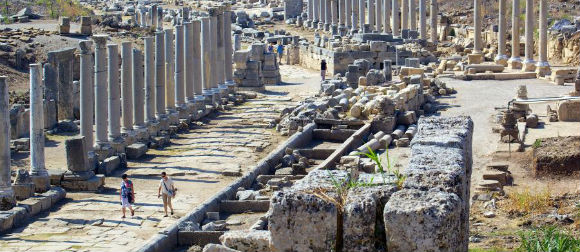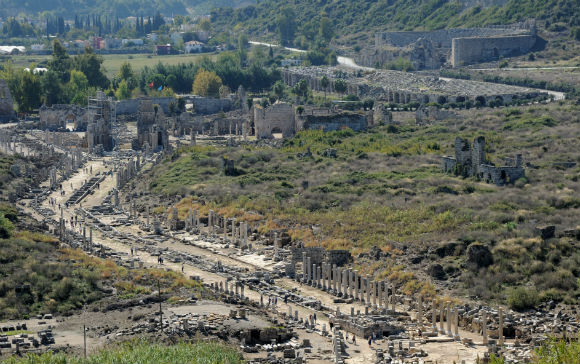The most impressive ruins of the Pamphylian coast are at Perge, at about 15 km east of Antalya. Perge was originally founded by the Hittites around 1500 BC. and was known as Parha. It was a successful trading centre near the Aksu (ancient Kestros or Cestrus) river when Alexander the Great arrived in 333 BC. He was welcomed in by the inhabitants and used Perge as base for his Anatolian campaigns. Alexander was followed by the Seleucids under whom the city prospered and Perge’s most celebrated inhabitant, the mathematician Apollonius from Perge lived and worked. Apollonius was a pupil of Archimedes and wrote a series of eight books on geometry. In 188 BC Perge became part of the Roman Empire during which the city flourished. Most of the surviving buildings date from this period.In 46 AD St. Paul started his journey in Perge (biblical Perga) and preached his first sermon here. Perge gradually declined during the Byzantine period, as the Aksu river silted, but remained inhabited until Selçuk times after which it became abandoned.
A visit to Perge starts by entering the archeological site through the Roman Gate, built during the reign of Septimius Severus (193-211 AD). Proceeding through the gate, to the right is the Agora or market place. This structure of 75 x 75 m dates back from the 2nd century AD. The center courtyard and shops were surrounded by a wide stoa, a covered walkway. The floor of the stoa and shops was made of colored mosaics. The agora was not only the centre of Perge’s trade, but was also a place for meetings as well as a forum for political, social, and philosophical discussions. The next building is the Hellenistic city gate that dates back to the 3rd century BC. This is certainly the most imposing building of the city and was cleverly designed to protect the city with its twin towers and its horseshoe-shaped courtyard at the back. It is thought that the towers had three floors and were crowned by a conical roof. In the year 121 AD, the horseshoe-shaped courtyard was rededesigned as a courtyard of honor. Behind the courtyard stood a triple arch. Around the arch there are about dozen inscriptions connected with Plancia Magna who lived in the 2nd century AD. She was the daughter of the governor, a priestess of Artemis Pergaia (Diana) and a benefactress to the city. Plancia Magna had the arch decorated with the statues of the emperors and their relatives.
After passing through the Hellenistic Gate and courtyard, one enters a broad, marble-paved double-colonnaded street measuring 300 meters in length that extends from the main gate to the acropolis. The street is 20 m wide and is divided in two by a 2 meter wide water channel running down the middle. At the end of the colonnaded street is the Nymphaeum, a triumphal fountain from where a stream flowed down into the water channel. The nymphaeum or nymphaion is an ornamental semicircular structure and dates from the reign of Emperor Hadrian (130-150 AD). A statue of a river god Kestros was located in the center of this huge fountain. Behind the nymphaeum is the acropolis with some remains of the Byzantine period. To the west of the nymphaeum are the remains of a palaestra dating from 50 AD and dedicated to the Emperor Cladius (41-54 AD).
Returning back to the entrance, there are the excavated Roman baths located southwest to the agora. Out of the site proper, is the horsehsoe-shaped stadium, the largest in Asia Minor, measuring 234 m by 34 m. The stadium had a seating capacity of 12,000 people supported by massive barrel-vaulted constructions. Just beyond the site entrance is also the theatre, which is of the Greco-Roman type and could seat 15,000 people. Unfortunately, it is for some time under reconstruction and unfortunately closed to visitors.
Perge,



We travelled by ourselves to this, the size of the ruins is immense. Think we would have got more out of the trip with a guide, but even so it was well worth the visit.
The best hypo cause I've seen Plunge pools clearly visible Just neeeded Cleopatra to have stayed there though St Paul comes close.
we visited Perge on a trip with our tour operator Thomson. The trip included Perge and the Roman Ampitheatre at Aspendos – currently costing £25 GBP with Thomsons in 2010. It is a half day trip picking up at 9 and ending at around 13.30.
We arrived at Perge and were walked around the main sights by our guide -…
We were very impressed by this site. The extent of the ruins is quite unexpected with large areas still to be uncovered.
The remains of the ruins have been well preserved especially the baths. You can still make out the marble that these baths were covered in. You also get to see the underground heating, amazing! You get a real feel for what this place may have looked like back in the day. Its a must see if you are in the…
A truly wonderful site visited on a local tour. . Huge ruins and even a little wild tortoise wandering about the Agora! Fabulous artifacts in the Antalya museum.
I know that Ephesus is the not-to-miss major attraction, and it should definitely be number one of all the things to see in Turkey. However, Perge is not to be missed! It is much more scaled down, has the most intricate detailed ruins that remain and is much less crowded. Perhaps because it is farther away than Istanbul than most…
Very interesting place, but i would suggest that you go with a guide. Souvenirs a little expensive and it only had a very small cafeteria.
Interesting and well preserved archeological site and combined with a visit to Antalya museum is a must
This visit was part of an organised tour covering the history of Turkey and well worth going on even if you are not that keen on history.